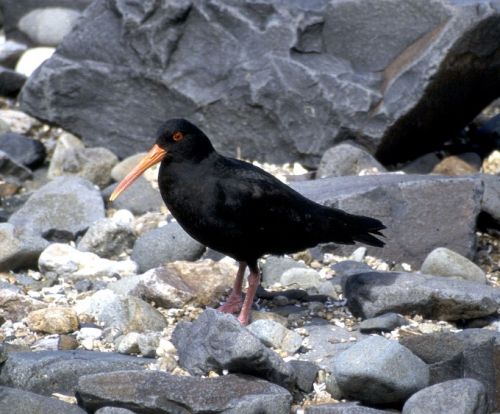- Haematopus unicolor
Identification
47–49 cm (18½-19¼ in)
- Variable plumage types from all black to pied
- Long orange-red bill and eye
- Pink legs
The black phase is the commonest throughout New Zealand, but the proportion of black birds increases the further south you go. In the North of North Island, 43% are black, 22% are pied and 35% are intermediates. In central New Zealand the ratio is 85:7:8 and in the south of South Island and on Stewart Island the ratio is 94:5:1. Juvenile is brownish-black, bill is brown/black and changes colour from about 3 months.
Similar Species
The only other species of Oystercatcher to occur in New Zealand is the Pied Oystercatcher (Haematopus ostralegus). The Pied phase of Variable Oystercatcher can be difficult to separate from Pied Oystercatcher in the field. However Variable Oystercatcher is larger and the border between the black and white plumage on the chest is less clearly defined in that species.
Distribution
Taxonomy
This is a monotypic species.
Chatham Oystercatcher was formerly considered conspecific with this species.
Habitat
They breed on sandy beaches and sand dunes. Rocky and sandy coasts.
Behaviour
Diet
Their diet consists of molluscs, worms, crabs, small invertebrates and small fish. They use their beak to split open bi-valves, especially oysters.
Breeding
The nest is a shallow scrape, sometimes lined with seaweed, on sandy beaches or rocky ledges. The clutch consists of 2 or 3 stone coloured eggs with small brown patches. They are incubated for about 28 days by both sexes. The chicks fledge at 2 days but stay with the parents to be fed for another 3 weeks. Although they learn to fly at 6-7 weeks old they don't leave the natal territory until about 3 months old.
Vocalisations
Most frequent call is a repeated slurred piping whistle peep or a doubled pi-peep.
References
- Clements, J. F., T. S. Schulenberg, M. J. Iliff, D. Roberson, T. A. Fredericks, B. L. Sullivan, and C. L. Wood. 2018. The eBird/Clements checklist of birds of the world: v2018. Downloaded from http://www.birds.cornell.edu/clementschecklist/download/
- Hockey, P., Kirwan, G.M. & Boesman, P. (2017). Variable Oystercatcher (Haematopus unicolor). In: del Hoyo, J., Elliott, A., Sargatal, J., Christie, D.A. & de Juana, E. (eds.). Handbook of the Birds of the World Alive. Lynx Edicions, Barcelona. (retrieved from http://www.hbw.com/node/53756 on 30 January 2017).
- Dowding, J.E. 2013. Variable oystercatcher. In Miskelly, C.M. (ed.) New Zealand Birds Online. http://www.nzbirdsonline.org.nz
- Marchant, S. & Higgins, P.J. (editors) 1993. Handbook of Australian , New Zealand & Antarctic Birds. Volume 2, Raptors to lapwings. Melbourne, Oxford University Press. Pages 648-649, 715,748-756; plate 56.
Recommended Citation
- BirdForum Opus contributors. (2024) Variable Oystercatcher. In: BirdForum, the forum for wild birds and birding. Retrieved 24 April 2024 from https://www.birdforum.net/opus/Variable_Oystercatcher
External Links
GSearch checked for 2020 platform.1






